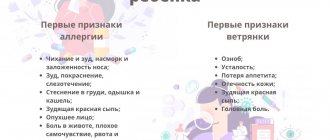by Doctor
Categories:
- Allergy treatment
Thanks to the immune system, our body:
- gets rid of harmful bacteria and viruses;
- removes toxins from the body;
- is cured of various diseases and prevents the development of those for which immunity has already been developed.
However, sometimes the immune system fights falsely dangerous microorganisms.
When our beloved cat appears, we begin to have a strange cough, and flowers given by loved ones cause watery eyes and itching in the nose.
And still doubting the symptoms that have appeared, we ask ourselves a natural question: do I have an allergy or a cold?
Why allergies and colds are similar
Like colds, allergies are predominantly seasonal. Most often, the disease begins (or worsens in the case of allergies) in the fall or spring. Sometimes allergies and colds can occur at the same time. In the first days, when your health changes and discomfort appears in the nasopharynx, it is especially difficult to recognize whether it is an allergy or an acute respiratory viral infection. However, there are several characteristic features that almost eliminate error.
For a cold infection:
- sneezing is rare but strong;
- copious discharge from the nose - first clear, then thick and with pus;
- In addition to a runny nose, other signs of an infectious disease appear, such as fever.
- frequent and superficial sneezing;
- watery nasal discharge;
- itching in the eyes or nose.
How to distinguish allergies from colds? If your jaw aches - this happens when you have a cold - then the question is removed. If sneezing, nasal congestion, and runny nose do not stop within 10 days, then it is an allergy. The temperature with allergies does not rise above normal.
Knowing the signs of infectious inflammation, you can easily understand how to distinguish an allergy from a cold in an adult. But the symptoms can be confused when a child is ill. It has its own characteristics. We will talk about them further.
Differences in treatment
When treating the flu, it is often recommended to gargle with chamomile or calendula infusion and drink herbal decoctions.
If a reaction to grass pollen occurs, such “treatment” can cause serious complications.
Also in this case, treatment with honey, tea with raspberries, or consumption of citrus fruits (for example, in the form of tea with lemon) will be unsafe.
You should be equally careful when choosing medications: syrups and herbal medications can aggravate the reaction and only cause harm.
During the flowering period of trees and grasses, an important part of treatment for allergy sufferers includes the exclusion of certain foods that can cause cross-reactions.
It is also dangerous to inhale with essential oils.
In case of allergic manifestations, be sure to take antihistamines and decongestants.
In general, treatment requires minimizing exposure to allergens as much as possible.
If this is not possible, then you can resort to immunotherapy - “accustoming” the body to the allergen by gradually introducing small doses of it by injection.
If you have a cold, on the contrary, it is better not to use vasoconstrictor medications for the nose, as this can worsen the course of the disease and even provoke complications.
A viral runny nose can go away on its own without treatment if your immune system is strong.
Unlike a cold, allergic rhinitis can last for months - during the flowering period of grasses or trees.
Differences and similarities of treatment:
| Cold | Allergy |
| antiviral drugs | antihistamines |
| reduce contact with other sick people (to avoid re-infection) | reduce contact with the allergen |
| strengthen the immune system | |
| physiological procedures | |
Sometimes our well-being leads us to a dead end. If your nose is running, your eyes are red, you want to constantly sneeze, you won’t be able to tell right away whether it’s an allergy or an acute respiratory viral infection? How to understand what exactly is happening in the body, since these ailments are treated differently? Further in the article we will try to understand in more detail how to distinguish allergies from colds in an adult or child.

Cold or hay fever?
It is believed that the champions among allergens are insects that are found in house dust. In second place in the allergy “rating” are flowers. Although with the onset of spring, probably, the first place remains with hay fever, and not with dust.
Spring is a time of exacerbation of all kinds of allergic reactions. Flowers and trees produce dust: alder, birch and hazel. By the way, allergic discomfort from pollen affects city dwellers more - city residents are diagnosed with allergies six times more often than rural residents. This feature is explained by air pollution in the city.
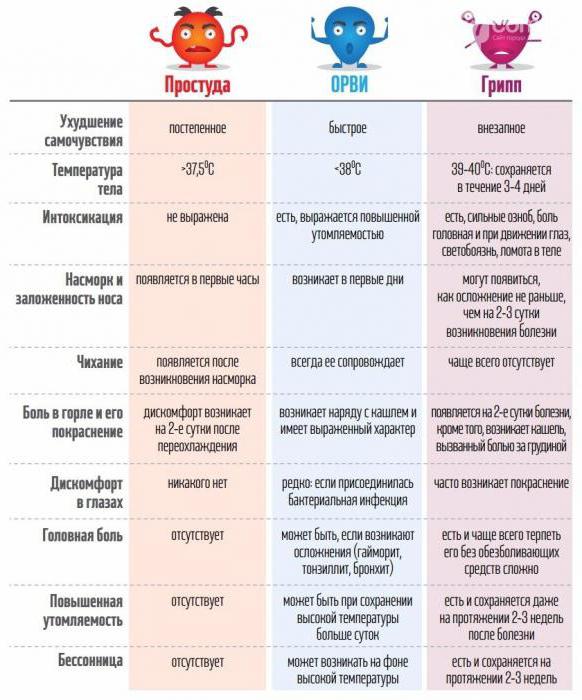
In the spring months, nasal congestion, sneezing, runny nose with discharge, and sore throat begin to bother you - is this an allergy or an acute respiratory viral infection? When bacteria and viruses “make their way” to the body, releasing poisons and toxins, they destroy protective mucus. The body “expels” pests in a very cunning way: when you sneeze, it gets rid of excess mucus along with germs. This neutralizes the attack of viruses. Therefore, sneezing is useful for the sneezing person, and those who are near him during a sneeze better take care.
If you have an allergy, the irritating agent will not go away with sneezing.
Causes of allergic rhinitis
Attacks of allergic rhinitis can be either seasonal or year-round.
Allergic rhinitis does not occur as often as colds, but is still a common problem among age groups. Attacks of allergic rhinitis can be either seasonal or year-round. Among the common factors influencing its development are:
- animal hair;
- plant pollen;
- Food;
- cosmetical tools;
- chemical substances;
- medications;
- dust;
- tobacco smoke.
Sputum production, frequent sneezing, nasal congestion - all these symptoms can be attributed to both allergic and infectious rhinitis. But allergic rhinitis can be recognized by additional signs:
- severe skin itching;
- dry strong cough;
- tearing and redness of the eyes;
- weakness and loss of smell.
After taking antihistamines, symptoms disappear or are weakened.
Why you need to treat allergies
Sometimes allergies can appear during a cold and be complicated by infectious inflammation. During an allergic reaction, swelling of the mucous membrane occurs, and this makes it difficult for the secretions to come out. And the longer an allergy or cold is not treated, the greater the likelihood of complications from an inflammatory infection.
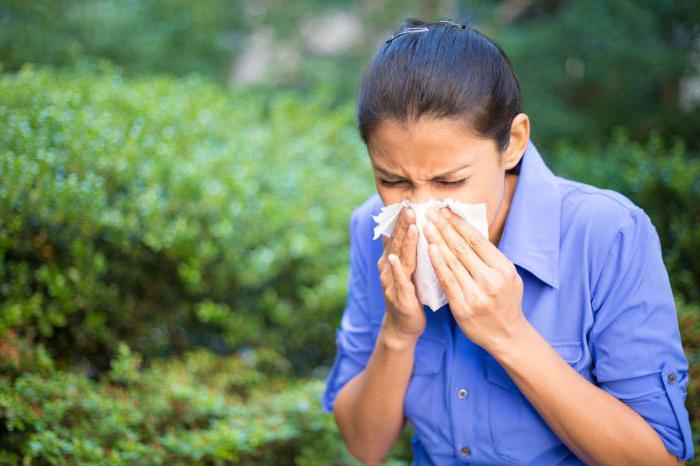
The sinuses should be completely cleared. If mucus accumulates, this will lead to secondary inflammation - viruses and microbes will still be in the cavity. Therefore, it is necessary to treat allergies in a timely manner. As soon as you feel nasal congestion, which is accompanied by profuse and frequent sneezing, and itching appears, you need to consult a doctor so that he can prescribe treatment in a timely manner.
In addition to following the medication course, try to give up spicy foods, smoking, alcohol and dairy products.
How to understand - an allergy or a cold: how to distinguish between an adult and a child
The winter period of the year is characterized by the frequent occurrence of colds: up to 90% of all cases of visiting a doctor are due to colds. However, you can also catch a cold in the summer season, which is already characterized by allergic reactions due to the flowering of trees, shrubs and cereals at different periods. The similarity of cold and allergy symptoms can cause mistakes when choosing a medicine.
The simplest definition of a cold is hypothermia of the body, which triggers self-healing processes.
Why does a child have a runny nose?
The nasal cavity is the first to encounter harmful viruses and bacteria that can cause inflammation. A runny nose, or rhinitis, is caused by a variety of viral and bacterial agents. By themselves, they do not cause significant concern, however, like any viral process, they can have a degree of severity and be accompanied by symptoms of intoxication.
As a rule, a healthy child’s body is able to cope with a runny nose in 7-10 days. If the illness drags on, it is worth thinking about the fact that a runny nose accompanies other diseases.
Bacteria or allergen?
The mucous membranes in the child’s body must produce mucus. This is a protective anti-inflammatory factor. If discharge appears, the cause must be determined in a timely manner.

Viral infections predominantly provoke clear, liquid mucus. With bacterial agents, thickening of the discharge and a change in color occur. Parents take the child to a pediatrician, who sees swelling of the mucous membranes and prescribes vasoconstrictor drugs. However, non-infectious agents can also cause nasal discharge. For example, allergic components, which, penetrating into the nasal cavity and into the respiratory tract, will also cause an abundance of mucus.
How to identify an allergen
Differential diagnosis may be difficult and special studies will be required.
Sometimes parents are afraid of the allergy examination procedure, believing that it will cause pain to the child. And completely in vain. Several test options are used to carry out the analysis. More often, a small and shallow scratch is made on the skin, smaller than a cat's claw mark. The child does not experience pain.

Allergens are placed in bottles. These are allergen concentrates from dog hair, tangerine, house dust, cow's milk, etc.
After a conversation with the parents, the allergist will prescribe an examination for a specific group of allergens.
Sometimes parents ask to be tested for all allergens that are in the allergist’s collection. But this is impossible, because it can lead to anaphylactic shock and reactions to various allergens. Although it is safe to do several tests for an allergen at one time.
Allergy: characteristics of the disease
This disease is notable for the scale of its spread: according to WHO (World Health Organization), at least 40% of the world's population have hypersensitivity to certain allergens.
Unlike colds, infectious pathogens are almost never involved in the development of allergies. Allergies are based on the phenomenon of hypersensitivity to certain allergens, which most often are:
- plant pollen (a special form of allergy - hay fever, or “hay fever”);
- house dust;
- molds;
- food products (eggs, cereals, milk, honey, nuts, etc.);
- insect bites/stings;
- medications (almost any medicine can cause allergies);
- and etc.
Allergies can manifest themselves in a variety of symptoms. All of them are divided into several groups depending on location - gastrointestinal, skin, ophthalmological, respiratory and others. Many of them are very similar to colds:
- allergic rhinitis - liquid, mucous discharge from the nose, light and odorless;
- burning and redness in the conjunctiva, lacrimation;
- skin rashes of various types;
- due to swelling, irritation and spasm of the smooth muscles of the upper respiratory tract, shortness of breath, asthma attacks, wheezing noisy breathing, and sneezing may occur.
How to distinguish an allergic cough from an infectious one
Cough is one of the symptoms of ARVI and allergies. And to understand its nature, you need to know the features of cough. If it is caused by an infection, there will be a fever.
If the general condition is unchanged and there are no other symptoms besides cough, then there is a significant probability that the cough is allergic.
Parents should tell the doctor about possible conditions that could affect the child's well-being. A doctor examining a child with a cough may not know that yesterday you used a new laundry detergent for the first time. The doctor should be informed about what changes have occurred in your child’s life. Then he will be able to make the correct diagnosis.
The two most common causes of cough in children are infection and an allergic agent. Moreover, in 90% of cases, cough appears due to ARVI. Along with it, a runny nose and fever begins. Before that, the child had contact with an infectious patient, from whom he received the virus.

And if you only have a cough, most likely it is not a viral infection.
How to distinguish an allergic runny nose from a cold: main differences, symptoms and treatment methods
- March 15, 2019
- Allergology
- Oskina Oksana Valentinovna
A runny nose is one of the most common pathologies. Most often it is caused by viral infections or colds. But recently, more and more often, runny noses in adults and children appear due to allergies. The symptoms appear almost the same as for a cold, although the causes of a runny nose and methods of treating it will be different. Incorrect therapy can lead to serious complications. But many people with a common runny nose do not even go to the doctor, trying to get rid of it on their own, often using traditional methods. And for allergies, such treatment not only does not help, but can lead to a worsening of the condition. Therefore, it is very important to know how to distinguish an allergic runny nose from a cold.
This condition is medically called rhinitis.
Signs of allergies
During allergic reactions, the following signs appear:
- Itching and inflammation in both eyes.
- Tears coming out for no reason.
- Frequent sneezing.
- If allergic manifestations are accompanied by pain in the throat, redness of the mucous tissues of the larynx is not observed.
- Due to swelling of the mucous tissues, the nose is stuffy.
- Hyperthermia is not typical for allergy symptoms; it is an extremely rare phenomenon.
- The general condition usually does not worsen due to the absence of toxin effects.
- Signs of allergic reactions clearly appear upon contact with an allergen. The body's response to a stimulus is lightning fast. When the cause is eliminated, the symptoms are significantly smoothed out. There is obvious relief.
- During winter, allergy symptoms last for several months.
- Allergies are characterized by rashes, redness, itching, and burning.
Important! If a cold continues for 7 days or more, you should visit an allergist.
Mucous discharge from the nasal passages is a common phenomenon and is usually accompanied by difficulty breathing, sneezing and itching in the nose. Rhinitis also has other symptoms. The disease is caused mainly by viral infections and is accompanied by drying out of the mucous membranes, excessive discharge and burning sensation. The disease is accompanied by hyperthermia, weakness and headaches. The pathology is characterized by a lack of appetite and possible complications in the ears.
Allergic rhinitis during pregnancy
How to distinguish allergies from colds in pregnant women? For the same reasons described above. But there is a difference in the principles of treating colds and allergies. It is necessary to rely on the advice of a doctor and avoid self-medication. If the doctor has diagnosed an allergy, then before using medications they usually suggest trying to first eliminate the allergen, such as pollen.
- Nasal filters that are inserted into the nose can help - they prevent the nasal mucosa from coming into contact with the allergen.
- The influence of allergens is also stopped by special sprays that create a film on the mucous membrane.
- It is better to avoid traveling to personal plots, forests or parks during the period when allergenic plants are blooming.
- It is recommended to use an air purifier in the room.
- If possible, it is better to temporarily move to another region where flowering does not occur.
If these barriers do not help and the allergen enters the body, causing a pronounced reaction, consult a doctor. You should not uncontrollably take vasoconstrictor drugs, which improve nasal breathing, but are not harmless. Only a doctor can select a therapy that is harmless to a pregnant woman and child. Today there are drugs that can help, that can relieve disturbing symptoms without affecting the mother and the unborn baby.

How to distinguish a cold from an allergy in a small child?
If you have a history of allergies, you should suspect the allergic nature of the runny nose, for example, vasomotor allergic rhinitis. If a child has an allergy to spring flowering plants, then it is not necessary that this will always happen only in the spring. Allergens are capable of mutating and changing the conditions of their pathogenic activity. It is possible that the baby may develop an allergy to household dust, pet hair, and certain odors.
Certain groups of viruses can infect the respiratory tract and provoke allergic reactions caused by reduced immunity. The opposite situation is also possible, when an allergic reaction without adequate therapy leads to respiratory diseases (inflammation of the maxillary sinuses, bronchial asthma, bronchitis, tracheitis). So, with allergies, the nasal mucous membranes thicken and the outflow of exudate to the outside is disrupted. This leads to the accumulation of mucus in the maxillary sinuses and sinusitis. When the disease is advanced, sometimes it is not possible to establish the true picture of the occurrence of the symptom complex.
In childhood, it is difficult for parents to independently distinguish one disease from another.
Read more about colds and allergies
The concept of a cold is not from medical terminology. People call a cold a disease in which:
- The nose is stuffy and there is discharge.
- Sore throat.
- A cough develops.
- Your head may hurt.
- Weakness and fever are observed.
Mild flu, ARVI: all this is often called a cold in everyday life. All these diseases are usually caused by a virus.
Allergies are not caused by viruses. Most often, it is based on heredity, and then children become hypersensitive to certain allergen irritants:
- Some products.
- Plant pollen (hay fever).
- Insect bites.
- Certain medications.
During allergic processes, there is a specific immune response to a specific allergen, which is dangerous and the immune system begins to fight the irritant with the release of histamine, provoking an allergic reaction.
In many children, allergies have seasonal manifestations; they may appear more often in the spring, for example, or in the fall.
The allergic process has many signs that can be localized on the skin, disrupt the digestive tract, manifest as respiratory symptoms or conjunctivitis.
Some manifestations of allergic properties are easy to confuse with colds. Parents are especially misled by runny noses and conjunctivitis, rashes, coughs, and hoarse breathing.
Such symptoms are typical for both colds and allergies. A feature of an allergic disease is that if not treated in a timely manner, severe complications may occur, such as Quincke's edema or anaphylaxis.
They are dangerous to the child's life. Therefore, in case of parental doubts, whether the child has an allergy or a cold, visit a specialist immediately so that the diagnosis is made accurately and qualified treatment is started on time.
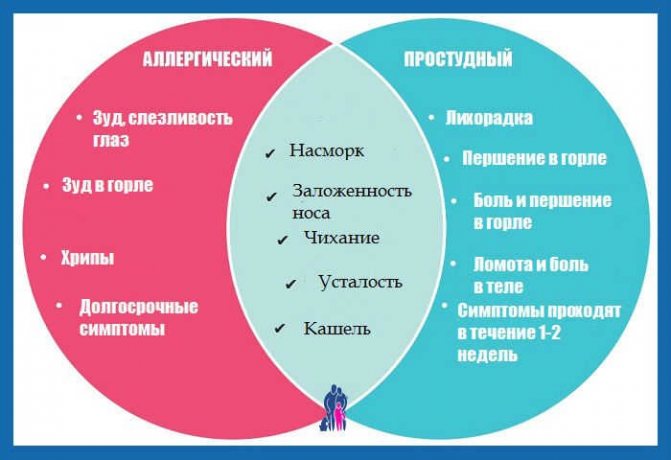
In many children, allergies have seasonal manifestations; they may appear more often in the spring, for example, or in the fall.
Distinguish allergies from colds in expectant mothers
The difference between a cold and an allergy during pregnancy will not have any special symptoms. Women expecting a baby are more often in a home environment, so they may become hypersensitive to dust, pet hair, feather pillows, etc. For this reason, expectant mothers are advised to pay attention to reducing contact with animals, frequent ventilation and more thorough cleaning, which it is advisable to entrust to one of the family members, so as not to encounter dust again.
Less commonly, allergies in expectant mothers occur as a result of hormonal changes. It should be noted that during pregnancy, a woman is advised to equally protect herself from any disease, be it an allergy or a cold. Since both of these conditions negatively affect the developing fetus, especially in the first weeks of gestation.
The connection between allergies and colds.
What are you allergic to?
Manifestations of hay fever are possible from March to August. The flowering season of trees lasts from March to May; in the summer, grasses bloom - first cereals, and in August - weeds. Allergies can be caused by one type of plant or several. Some people react only to pollen from trees or grasses, others to both, suffering from March to August.
Runny nose or allergies in an infant?
Parents need to know how to distinguish allergies from colds in infants.
If a runny nose does not go away for a long time and rashes begin, then most likely it is an allergy. The doctor will prescribe the correct treatment, but parents can rid the baby of mucus accumulations - both for a cold and for an allergic reaction.
It is usually recommended to drip nasal liquefaction products into the nose. They moisturize the nasal mucosa and prevent the development of a complex runny nose. You can use drops based on sea water. It is enough to drop one drop of the product into each nostril. After five minutes, you can “suck out” the accumulation of mucus with a small bulb. To ensure that the procedure is successful and does not cause discomfort to the baby, lightly hold the baby’s head with your hand: if he spins, nothing will work.
You can also use drops approved for infants.
How not to confuse an allergic reaction with a cold
- A cold is often preceded by hypothermia and allergic contact with an irritant.
- It is necessary to monitor the child's temperature. In case of allergy development, there is practically no increase in temperature.
- Duration of symptoms. A cold lasts a maximum of ten days; allergies will not go away so quickly, especially if there is no special treatment. For example, rhinitis caused by allergies can last a very long time, especially intensifying during periods of flowering plants (this indicates the child’s hypersensitivity to pollen). If allergic symptoms depend on something in the apartment, rhinitis generally becomes year-round.
- Seasons also matter. If you think your child is getting colds during the spring and summer months, it is usually caused by an allergen. How to distinguish allergies from colds in a child in the spring? It’s warm and pleasant to walk, but your child is sneezing, has a runny nose, and tears are flowing from his eyes. Perhaps the provocateur is pollen, and not a common cold. In summer, allergic symptoms often come from mosquito, bee, and wasp bites. Vegetables and fruits that contain irritants that cause allergic symptoms also provoke allergies.
- Nasal discharge. With a runny nose of allergic origin, the nasal passages in children swell, but the discharge is typically transparent. And cold mucus from the nose is viscous and greenish. Rhinitis with allergies is almost sudden; with a cold, a runny nose develops much more slowly. A runny nose due to allergies, as a rule, “comes” along with conjunctivitis (also of an allergic nature).
- The throat hurts with colds, and not with allergic processes. However, in the latter case, the throat may feel sore and itchy.
- A cough is more likely to accompany a cold, but it can also accompany allergies. The nature of the cough is different: in the first case, it will become moist after a few days, but for an allergic disease, dry cough is a common symptom; such a cough, if the allergy is not treated, will not go away on its own.
- Genetic factor. Parents with allergies should watch especially carefully for the appearance of symptoms reminiscent of a cold, since allergies are inherited.
Let us highlight the main thing in the question of how to distinguish allergies from colds in children. A cold is always accompanied by general intoxication: the child has lethargy, weakness, and fever.
An allergic disease is not accompanied by general intoxication when a number of other manifestations coincide: from rhinitis to cough. Eyes with a cold never itch; a rash is an extremely rare occurrence, but with allergies these are characteristic symptoms.
It is especially common for allergic manifestations to hide “under the guise” of a cold when children are still small (up to five years old).
If kids get colds several times a year, parents should definitely go with him to an allergist for examination.
What about the babies?
How to distinguish allergies from colds in infants? Parents should know that infants almost never develop an allergic runny nose.
If rhinitis appears, this is probably a marker of a cold. Infants suffering from allergic manifestations are more likely to experience redness and rashes on the skin, sour eyes, swelling of the eyelids, disturbances in the gastrointestinal tract, severe tearing, and general anxiety.
You need to urgently visit an allergist to avoid severe forms of allergic disease.
The difference between allergies and colds: how to identify and treat correctly
The complex of symptoms of acute allergic conditions, especially those manifestations that are associated with impaired functioning of the ENT organs, is often very similar to the symptoms of colds and acute respiratory viral infections.
In addition, an allergy sufferer may not know about the presence of the disease for a long time (before the first close encounter with an allergen) and not think about whether the allergy can manifest itself as a cold. Below we will discuss how to distinguish allergies from colds.
The role of immunity in allergic reactions
In our country, it has long been customary for those suffering from allergies to suspect a weak immune system and try in every possible way to strengthen it with immunostimulating drugs, vitamins, etc. But the fact is that it is precisely these actions that help its symptoms become even more pronounced. Therefore, in order to understand how to distinguish an allergy from a cold, you first need to understand how the immune system works in the first case and why it declares war on harmless substances.
An allergy is a strong immune reaction of the body to an irritant. That is, the body perceives poplar fluff, ragweed pollen, fruits or vegetables as danger and begins to fight them.
As it turns out, this is due to a general addiction to excessive personal cleanliness and sterility in rooms, especially in the room of a small child. And this, it turns out, can play a cruel joke in the future - the immune system, which is genetically programmed for life in a cave and contact with three billion microorganisms, turns out to be deprived of work and therefore simply “throws itself” at everything that even slightly resembles the “enemy”.
This is how allergies are formed. For many, it takes on a seasonal character - that is, at a certain time of the year (by the way, not necessarily at the time of flowering) a person receives a set of symptoms similar to those of a cold.

Understanding the definitions
To determine whether a cold or allergy has contributed to the occurrence of unpleasant symptoms that impede the functioning of the respiratory system, you need to understand the nature of these diseases and know what factors trigger their development.
The word “cold” is commonly used to refer to a group of respiratory diseases of an infectious (viral) nature. These ailments are accompanied by inflammation of the tonsils and mucous membrane of the nasopharynx. A cold begins after a virus enters the body, which is transmitted by airborne droplets from the carrier of the infection. The disease develops if a person’s immune system is not able to cope with this virus.
Due to the existence of a very large number of strains and their tendency to mutate, the presence of immunity to certain strains does not mean immunity to the virus in principle. Signs of a cold are traditionally hyperthermia, difficulty in nasal breathing, runny nose, weakness, decreased performance, and often sore throat or a wet cough.
The condition lasts on average about a week. To eliminate symptoms, vasoconstrictor drops, lozenges, sprays for irrigation of the oropharynx, and drugs that bring down the temperature are used. The sick person does not need to take antiviral drugs - our own immunity copes with the infection.
Common features and differences between colds and allergies in adults
How can you find out which pathology is found in the patient? Let's look at the general features of allergies and colds:
- with these pathologies, there is a cough and runny nose, sneezing, watery eyes, and nasal discharge;
- some allergic manifestations (for example, those associated with plant allergens - pollen, etc.) make themselves felt in spring and autumn. The peak incidence of ARVI also occurs during these periods of the year.
The main differences between colds and allergies:
- the first days of a cold are often accompanied by an increase in temperature, which makes it possible to distinguish it from diseases of a non-infectious nature (hyperthermia is not observed with allergies);
- Colds are not characterized by rashes;
- the allergy is not accompanied by feverish and intoxicating symptoms, muscle pain, body aches, or decreased performance;
- a cold goes away on its own after one to two weeks, allergic phenomena disappear only after some time has passed after contact with the substance that caused the reaction has been eliminated.
In addition, there are a number of differences in the very nature of the main manifestations of dysfunction of the ENT organs. Using them, you can more accurately determine what the patient is sick with.
Runny nose
With both diseases, the patient begins to have a runny nose - this is how the mucous membrane reacts to vasodilation. Let's look at the differences between common and allergic rhinitis:
- With allergies, the patient sneezes quite often. He has scanty liquid discharge from his nostrils. Sometimes itching in the nose occurs when sneezing or even at rest. Uncontrollable tearing may occur. Swelling of the mucous membrane is also very pronounced. Some allergy sufferers experience dark circles under their eyes. These phenomena can bother the patient for a long time, until contact with the allergen stops. If a runny nose generally develops quickly, is not accompanied by hyperthermia, weakness or sore throat, and the listed features are observed, this definitely speaks in favor of an allergy;
- a patient with a cold sneezes much less often, but more intensely. His pathological process develops more slowly, and nasal discharge has a thicker consistency and is often greenish in color. It is also possible to have swollen lymph nodes in the neck, chin and behind the ears.
A sore throat

A cold can also be distinguished by the presence of a symptom such as a sore throat. Its presence is associated with infection of the tonsils. In this case, the tonsils become swollen and inflamed, and the patient experiences intense pain when swallowing.
There are no such phenomena with allergies. But swelling of the nasopharyngeal mucosa occurs, which is sometimes accompanied by itching in the throat.
Cough

How to understand whether an allergy or a cold is bothering the patient if in both cases a severe cough appears? Studying the nature of the cough helps distinguish a cold from an allergy.
An allergic cough is dry and not accompanied by sore throat. Often wheezing can be heard during coughing. A patient with a cold coughs without phlegm for the first two to three days, but later the cough becomes wet.
Difficulty in nasal breathing
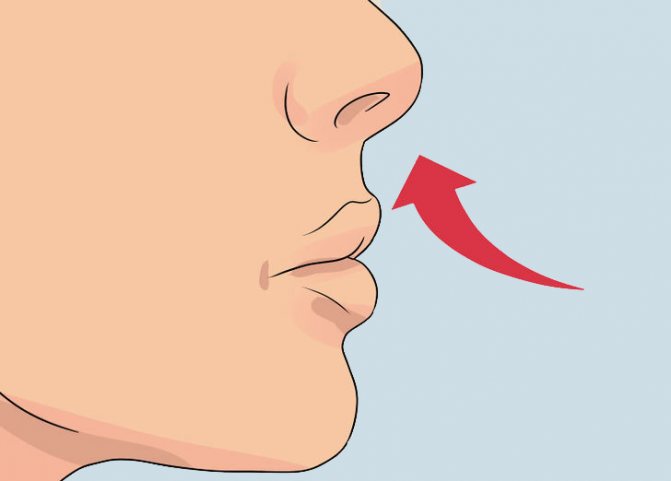
In an adult patient, allergies can be differentiated by swelling of the mucous membrane, which causes severe difficulty breathing.
In this case, in addition to vasoconstrictor drops, antihistamines can also alleviate the allergy sufferer’s condition.
Colds: common signs
A cold is a purely colloquial concept that does not have a full-fledged analogue in official medical terminology. “People” understand a cold as a disease of the upper respiratory tract due to hypothermia, accompanied by characteristic symptoms, such as:
- nasal congestion and discharge (the most common manifestation);
- a sore throat;
- cough;
- headache;
- malaise, weakness;
- slight increase in temperature.
In medicine, this condition corresponds in almost all respects to acute nonspecific rhinitis.
In some other cases, with a mild course, a cold may be called influenza, laryngitis, ARVI (acute respiratory viral infection), manifestations of labial herpes and other nosological units.
The confusion is mainly caused by the fact that the mechanism of development of the cold is clearly related to hypothermia as the main cause, while in the case of acute nonspecific rhinitis or other diseases, hypothermia is not the cause, but only a factor that contributes to the weakening of protective mechanisms and the activation of infectious agents . In this article, we propose to accept the concepts of “cold” and infectious rhinitis, acute respiratory infections, acute respiratory viral infections, etc. for synonyms.
The cause of a “cold” is an infection, in the vast majority of cases it is viral. There are quite a large number of different viruses that can cause the symptoms described. But most often the role of pathogen is played by rhinoviruses, coronaviruses, adenoviruses, Coxsackie viruses, etc.
Differences between allergies and colds in children
Let's look at how to distinguish allergies from colds in a child. Signs of allergic conditions, similar to colds (nasal mucus, etc.), appear in children starting from the age of two.
Moreover, the older the child is, the more often the symptoms will make themselves felt. If your baby complains of a runny nose or nasal congestion, you need to ask him if he smelled any flowers - it is quite possible that these are symptoms of an allergic process.
Its presence is also indicated by abundant clear discharge and a burning sensation in the nose. Often such patients experience redness of the eyes, certain bowel irregularities (in the case of children 2-5 years old), skin rashes and lacrimation.
How to distinguish a cold in the presence of a runny nose and hyperemia of the mucous membrane? This can be done by the presence of such signs as a hyperthermic reaction, weakness, lack of appetite and decreased activity.
Nasal discharge will be thick, opaque, sometimes with purulent inclusions. It is very difficult for a child to breathe through his nose in his sleep (he begins to breathe through his mouth). The baby will also complain of pain when swallowing. It is noteworthy that in a child, difficulty breathing during sleep is a sign of a cold, and in adults this symptom often accompanies allergies.
Main symptoms
The symptoms of these two diseases are very similar, in order to distinguish them and begin proper treatment, the following features should be taken into account:
- Itching in the nose area. Nasal congestion and rhinitis are common symptoms of both allergies and a runny nose. But only in the first case does it begin in the back of the nasal cavity, and it is quite difficult to relieve it.
- Sneezing. With a cold, it will be loud, infrequent and very deep, which is associated with attempts to clear the bronchi. With allergies, sneezing is quiet and frequent, this is an attempt to remove the irritating factor from the nasal cavity.
- Tearing. In case of allergies, it is abundant and strong; during colds, the eyes will water periodically and not very much.
- The color of mucus discharged from the nose. During a cold, the discharge has a characteristic greenish and yellow tint; with allergies, it is transparent.
- Cough. This symptom is characteristic of colds; it rarely appears in allergic reactions.
- Circles under the eyes. This is a typical symptom of an allergy, caused by chronic nasal congestion or reduced ability of the veins in that area to drain. With colds, this symptom is absent.
A cold in a child or adult is caused by viruses; this provokes fever, general weakness, cough and rhinitis, and sore throat. Nasal discharge is thicker and yellow or green in color. But the main difference is the fever, which intensifies in the evening, and muscle pain, which are absent with allergies.
During seasonal allergies, the main symptoms will be itchy eyes, reddened whites, difficulty breathing due to congestion, rhinitis, sneezing and very severe itching at the back of the nose.
All these symptoms are due to the fact that the body is trying to independently remove the irritating factor from the body. For this reason, there are no signs such as muscle aches and fever, but dark circles under the eyes may be present. A characteristic feature of seasonal allergies is that when walking, the general condition worsens.

Preventive measures

To prevent the occurrence of allergic manifestations, it is important to try to avoid contact with the allergen. When this is not possible, antihistamines and decongestants should be used during the appropriate period - they will significantly alleviate the patient’s condition.
Steroid medications can be taken as prescribed by a doctor. It is also acceptable to use nasal drops to make breathing easier and reduce the intensity of nasal discharge.
In no case should you use herbal medicines (which are often taken by patients with a cough and runny nose) - there is no guarantee that the patient is not allergic to the components they contain.
Such remedies often only worsen the condition. The patient's home needs to be wet cleaned regularly. It is also recommended to avoid carpets, as they accumulate a lot of dust. If the patient shows signs of complications, you need to call a doctor.
To prevent the development of a cold, it is necessary to ensure that you have as little contact as possible with carriers of viruses, if possible. At the same time, parents need to know that the risk of developing diseases of this type is determined by the state of the immune system.
Therefore, in the preschool years, a child, having an undeveloped immune system, will inevitably suffer from colds and ARVI several times a year.



